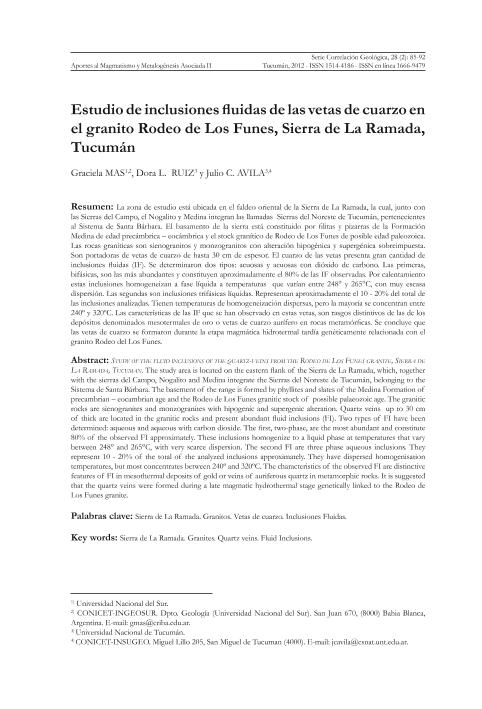Artículo
La zona de estudio está ubicada en el faldeo oriental de la Sierra de La Ramada, la cual, junto con las Sierras del Campo, el Nogalito y Medina integran las llamadas Sierras del Noreste de Tucumán, pertenecientes al Sistema de Santa Bárbara. El basamento de la sierra está constituido por filitas y pizarras de la Formación Medina de edad precámbrica - eocámbrica y el stock granítico de Rodeo de Los Funes de posible edad paleozoica. Las rocas graníticas son sienogranitos y monzogranitos con alteración hipogénica y supergénica sobreimpuesta. Son portadoras de vetas de cuarzo de hasta 30 cm de espesor. El cuarzo de las vetas presenta gran cantidad de inclusiones fluidas (IF). Se determinaron dos tipos: acuosas y acuosas con dióxido de carbono. Las primeras, bifásicas, son las más abundantes y constituyen aproximadamente el 80% de las IF observadas. Por calentamiento estas inclusiones homogeneizan a fase líquida a temperaturas que varían entre 248° y 265°C, con muy escasa dispersión. Las segundas son inclusiones trifásicas líquidas. Representan aproximadamente el 10 - 20% del total de las inclusiones analizadas. Tienen temperaturas de homogeneización dispersas, pero la mayoría se concentran entre 240º y 320ºC. Las características de las IF que se han observado en estas vetas, son rasgos distintivos de las de los depósitos denominados mesotermales de oro o vetas de cuarzo aurífero en rocas metamórficas. Se concluye que las vetas de cuarzo se formaron durante la etapa magmática hidrotermal tardía genéticamente relacionada con el granito Rodeo del Los Funes. The study area is located on the eastern flank of the Sierra de La Ramada, which, together with the sierras del Campo, Nogalito and Medina integrate the Sierras del Noreste de Tucumán, belonging to the Sistema de Santa Bárbara. The basement of the range is formed by phyllites and slates of the Medina Formation of precambrian - eocambrian age and the Rodeo de Los Funes granitic stock of possible palaeozoic age. The granitic rocks are sienogranites and monzogranites with hipogenic and supergenic alteration. Quartz veins up to 30 cm of thick are located in the granitic rocks and present abundant fluid inclusions (FI). Two types of FI have been determined: aqueous and aqueous with carbon dioxide. The first, two-phase, are the most abundant and constitute 80% of the observed FI approximately. These inclusions homogenize to a liquid phase at temperatures that vary between 248° and 265°C, with very scarce dispersion. The second FI are three phase aqueous inclusions. They represent 10 - 20% of the total of the analyzed inclusions approximately. They have dispersed homogenisation temperatures, but most concentrates between 240º and 320ºC. The characteristics of the observed FI are distinctive features of FI in mesothermal deposits of gold or veins of auriferous quartz in metamorphic rocks. It is suggested that the quartz veins were formed during a late magmatic hydrothermal stage genetically linked to the Rodeo de Los Funes granite.
Estudio de inclusiones fluidas de las vetas de cuarzo en el granito Rodeo de los Funes, Sierra de La Ramada, Tucumán
Título:
Study of the fluid inclusions of the quartz-veins from the Rodeo de los Funes granite, Sierra de la Ramada, Tucuman
Fecha de publicación:
07/2012
Editorial:
Instituto Superior de Correlación Geológica
Revista:
Serie Correlación Geológica
ISSN:
1514-4186
1666-9479
1666-9479
Idioma:
Español
Tipo de recurso:
Artículo publicado
Clasificación temática:
Resumen
Palabras clave:
Sierra de La Ramada
,
Granitos
,
Vetas de Cuarzo
,
Inclusiones Fluidas
Archivos asociados
Licencia
Identificadores
Colecciones
Articulos(INSUGEO)
Articulos de INST.SUP.DE CORRELACION GEOLOGICA
Articulos de INST.SUP.DE CORRELACION GEOLOGICA
Citación
Mas, Graciela Raquel; Ruiz, Dora L.; Avila, Julio Cesar; Estudio de inclusiones fluidas de las vetas de cuarzo en el granito Rodeo de los Funes, Sierra de La Ramada, Tucumán; Instituto Superior de Correlación Geológica; Serie Correlación Geológica; 28; 2; 7-2012; 85-92
Compartir




